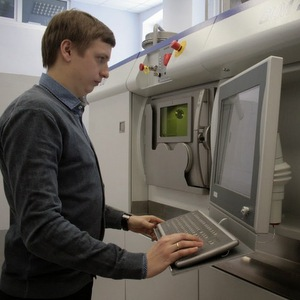
English > News
SSAU scientists will be engaged in printing 3D elements of the promising aviation and space technology
07.03.2015, 17:08
Engineers of SSAU laboratory of additive technologies started to carry out experiments in the field of 3D-printing of metal parts, components and assemblies.
The research of Samara scientists will allow producing highly complex and non-standard elements of spatial forms required for design and creation of advanced aviation and space technology.
Samara State Aerospace University has been engaged in developments in the field of producing the parts and components of aircraft engines with the use of 3D-printing since 2011. The technology allows you to produce complex elements on a tight schedule, which production by traditional methods is very difficult and expensive.
Until recently, SSAU laboratory of additive technologies used 3D-printing in the manufacture of metal products mainly to create master patterns and shapes, where it will carry out the investment process of finished products.
In February 2015 a new installation was put into operation, which allows you to "print" the desired part or assembly directly from metal powder. With high-power laser, it can fuse or powders stainless tool steel, cobalt-chromium, aluminium, titanium and nickel.
“Upon completion of the work on computer model of the product, engineer gives the command "print" and after a few hours or days, depending on the size of the object, receives the finished product”, - said Vitaliy Smelov, Head of SSAU laboratory of additive technologies. – Technology of laser-sintering of metals allows the creation of parts of any configurations which cannot be manufactured by conventional techniques such as moulding or stamp”.
In addition, SSAU specialists are intended to proceed with the development of bionic structures using the new equipment.
It is about the design and manufacture of engineering products, repeating complex natural forms. Such an approach allows reducing the weight of items ten times, while maintaining the necessary strength characteristics.
In particular, by the order of JSC "Kuznetsov" the research is conducted to facilitate turbine supports of aircraft engine in 2-3 times. Until now, this engine component was manufactured by casting. With help of 3D-laser printing it acquires a porous bone structure, which allows making it easier to construct, but retain strength properties.
Equipment for 3D-printing of metal products will be widely used by the laboratory in other areas of scientific research. For example, in medicine.
The implants produced on it reduplicate anatomical features of a particular person in minute particulars, and can be used in dentistry and surgery, including for the treatment of complex spine and joints fractures.
For reference
Additive technologies (from the English additive) allow to "growing" the details of the different forms of any complexity using a laser. Currently, it is one of the most advanced areas of research in the world science.
SSAU Laboratory of Additive Technologies is established in 2011. Since its creation the laboratory specialists are involved in research of developing the advanced aviation and space technology, as well as in the projects of aircraft engines modernization.
Within a framework of a project on creation a virtual gas turbine engine for the ground power plants together with JSC "Kuznetsov" was made prototypes of experimental designs in wax for subsequent casting in the shops of the enterprise. The works restoring the production of NK-33 engine are performed together with JSC "Kuznetsov".
As part of the project SSAU laboratory of additive technologies develops advanced technological processes and produce tooling, as well as investment patterns for pilot production.
In addition to prospective studies, since 2012 the laboratory is engaged in repair of compressor blades of gas turbine engine: using the Russian installation "Bulat- HTC Mobile 300" the laboratory staff perform welding of blades that grind off during the operation.









